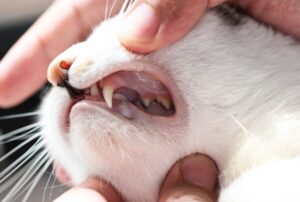
Since it’s pet dental month, Mount Carmel Animal Hospital is sharing information about feline odontoclastic resorptive lesion.
When something is off with your cat, it can be difficult to tell sometimes. Cats are notoriously good at hiding when they aren’t feeling well. They do show subtle changes, and you can notice things such as abnormal behavior as a sign of an illness. Since it’s pet dental month, Mount Carmel Animal Hospital is sharing information about feline odontoclastic resorptive lesion (FORL) and their impacts on your feline’s health.
What is a Feline Odontoclastic Resorptive Lesion (FORL)?
Feline odontoclastic resorptive lesion, or tooth resorption, is a prevalent condition that affects an estimated 20% to 60% of all cats, especially those five years of age or more. There are several theories on what causes this condition; however, there is yet to be a definitive answer.
Within your cat’s teeth is a chamber, or root canal, that contains tissue made of blood vessels, nerves, and lymphatic vessels. This tissue is surrounded by a bony substance called dentin, primarily the bulk of the tooth’s structure. In FORL, your cat’s dentin in single or several teeth erodes and becomes irreversible destroyed. Over time, all areas of an affected tooth might become involved. Basically, your cat’s tooth disintegrates within his or her mouth.
Signs and Symptoms of FORL
Regarding the clinical signs of feline odontoclastic resorptive lesion, this can be hard to tell. Loss of appetite may occur if the crown were to come off from your cat’s tooth. In that case, your pet can be off its food for a particular time, from 24 to 72 hours. However, the condition has to be extreme before your feline stops eating. If there are multiple resorptive lesions in the oral cavity, your cat will begin swallowing its food without chewing it or suddenly prefer soft food. Your cat may also start favoring one side of his or her head when chewing. This would be noticeable because your kitty may tilt his or her head to one side when chewing.
Furthermore, your pet might demonstrate excruciating pain when it bites down on an affected tooth or if a veterinarian touches it with probing fingers or an examining tool. This would likely be demonstrated by sudden vocalization while eating.
Treatment
The best way to confirm suspecting presence of feline odontoclastic resorptive lesion is via a full-mouth intra-oral radiograph. This will allow us to visualize the entire tooth structure, both above and below the gum line. Intra-oral radiographs allow us to detect resorptive lesions before they advance to the point of affecting the crown. If a veterinarian at Mt. Carmel Animal Hospital discovers the presence of tooth resorption, the only effective treatment is to extract the affected teeth. This will eliminate the source of the pain your cat is experiencing.
HERE AT MOUNT CARMEL ANIMAL HOSPITAL, WE’LL TREAT YOUR PETS LIKE FAMILY!
Mount Carmel Animal Hospital has been serving the Northern Baltimore/Southern York community for over 30 years and is proud to be an independently operated, small animal practice committed to excellence in veterinary medicine and client service. From grooming to wellness services, along with Canine Life Skills Training Courses, and surgical procedures, we have the expertise that will best serve the needs of you and your pet. Contact us at 410-343-0200 and follow us on Facebook!
